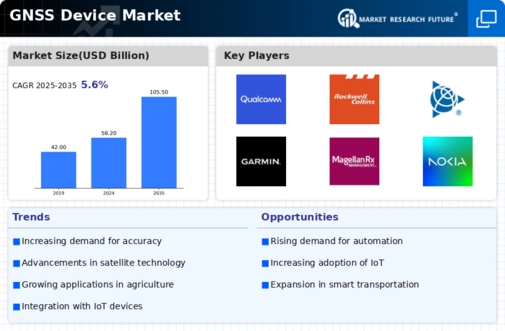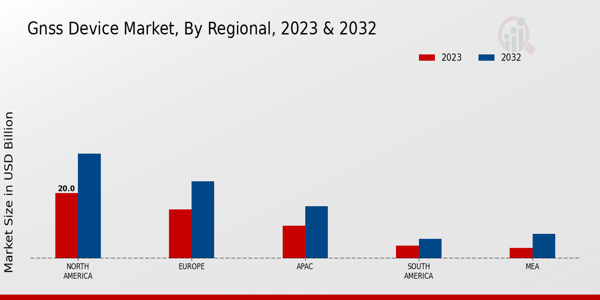Market Growth Projections
The Global GNSS Device Market Industry is projected to experience substantial growth in the coming years, with estimates indicating a market value of 58.2 USD Billion in 2024 and a potential increase to 105.5 USD Billion by 2035. This growth trajectory suggests a compound annual growth rate of 5.56% from 2025 to 2035. Factors contributing to this growth include technological advancements, increasing demand for navigation services, and the expansion of GNSS applications across various sectors. As industries continue to recognize the value of GNSS technology, the market is likely to evolve, presenting new opportunities for innovation and investment.
Growth of the Automotive Sector
The automotive sector is a major driver of the Global GNSS Device Market Industry, as the demand for connected and autonomous vehicles rises. Automakers are increasingly incorporating GNSS technology for navigation, fleet management, and vehicle tracking. The integration of GNSS in electric vehicles is also gaining traction, as it aids in route optimization and energy management. This trend is expected to propel the market forward, with the automotive industry accounting for a substantial share of the overall GNSS device market. As vehicle manufacturers prioritize safety and efficiency, the adoption of GNSS technology is likely to accelerate, further enhancing market growth.
Government Initiatives and Investments
Government initiatives and investments significantly influence the Global GNSS Device Market Industry. Various countries are investing in GNSS infrastructure to enhance national security and improve public services. For example, the European Union's Galileo program aims to provide high-precision positioning services, fostering the development of GNSS applications across Europe. Similarly, the United States continues to invest in the modernization of the Global Positioning System (GPS), ensuring its reliability and accuracy. These initiatives not only bolster the market but also encourage private sector participation, leading to innovative solutions and increased adoption of GNSS technology across multiple sectors.
Increasing Demand for Navigation Services
The Global GNSS Device Market Industry experiences a surge in demand for navigation services across various sectors, including automotive, aviation, and maritime. As urbanization accelerates, the need for precise navigation solutions becomes paramount. For instance, the automotive sector is integrating GNSS technology into advanced driver-assistance systems, enhancing safety and efficiency. This trend is projected to contribute to the market's growth, with the industry expected to reach 58.2 USD Billion in 2024. The proliferation of smartphones and wearable devices further fuels this demand, as consumers increasingly rely on location-based services for daily activities.
Technological Advancements in GNSS Devices
Technological advancements play a pivotal role in shaping the Global GNSS Device Market Industry. Innovations such as multi-frequency GNSS receivers and enhanced signal processing capabilities are improving accuracy and reliability. These advancements enable applications in precision agriculture, surveying, and autonomous vehicles, where high precision is crucial. The integration of GNSS with other technologies, such as Internet of Things (IoT) and artificial intelligence, is expected to create new opportunities for growth. As these technologies evolve, they are likely to drive the market towards an estimated value of 105.5 USD Billion by 2035, reflecting a compound annual growth rate of 5.56% from 2025 to 2035.
Emerging Applications in Various Industries
Emerging applications across diverse industries are reshaping the Global GNSS Device Market Industry. Sectors such as agriculture, construction, and logistics are increasingly adopting GNSS technology for improved operational efficiency. In agriculture, precision farming techniques utilize GNSS for crop monitoring and yield optimization, leading to higher productivity. The construction industry employs GNSS for site surveying and project management, enhancing accuracy and reducing costs. In logistics, GNSS enables real-time tracking of shipments, improving supply chain efficiency. As these applications expand, they are expected to drive the demand for GNSS devices, contributing to the overall growth of the market.

























Leave a Comment